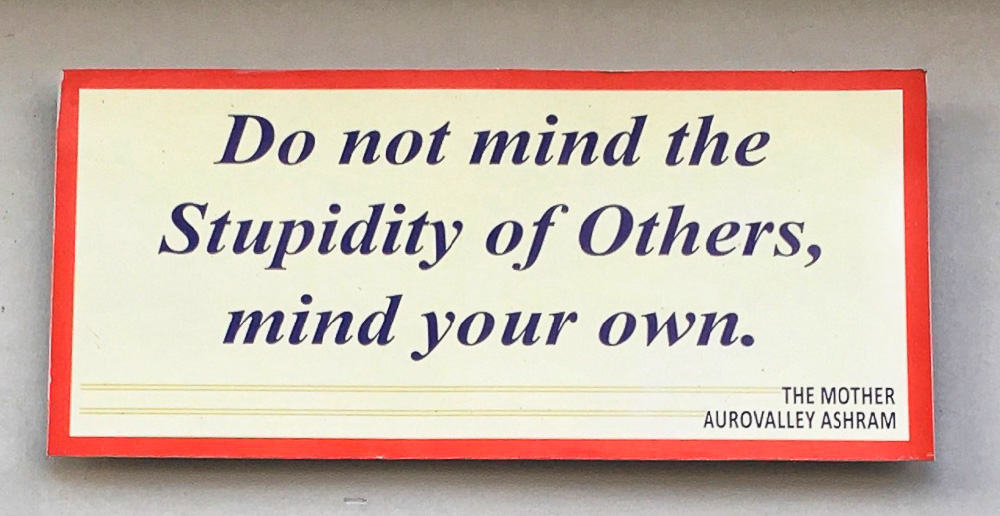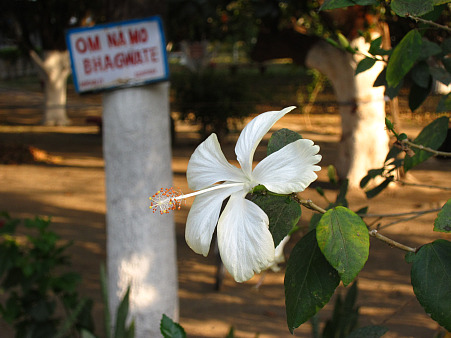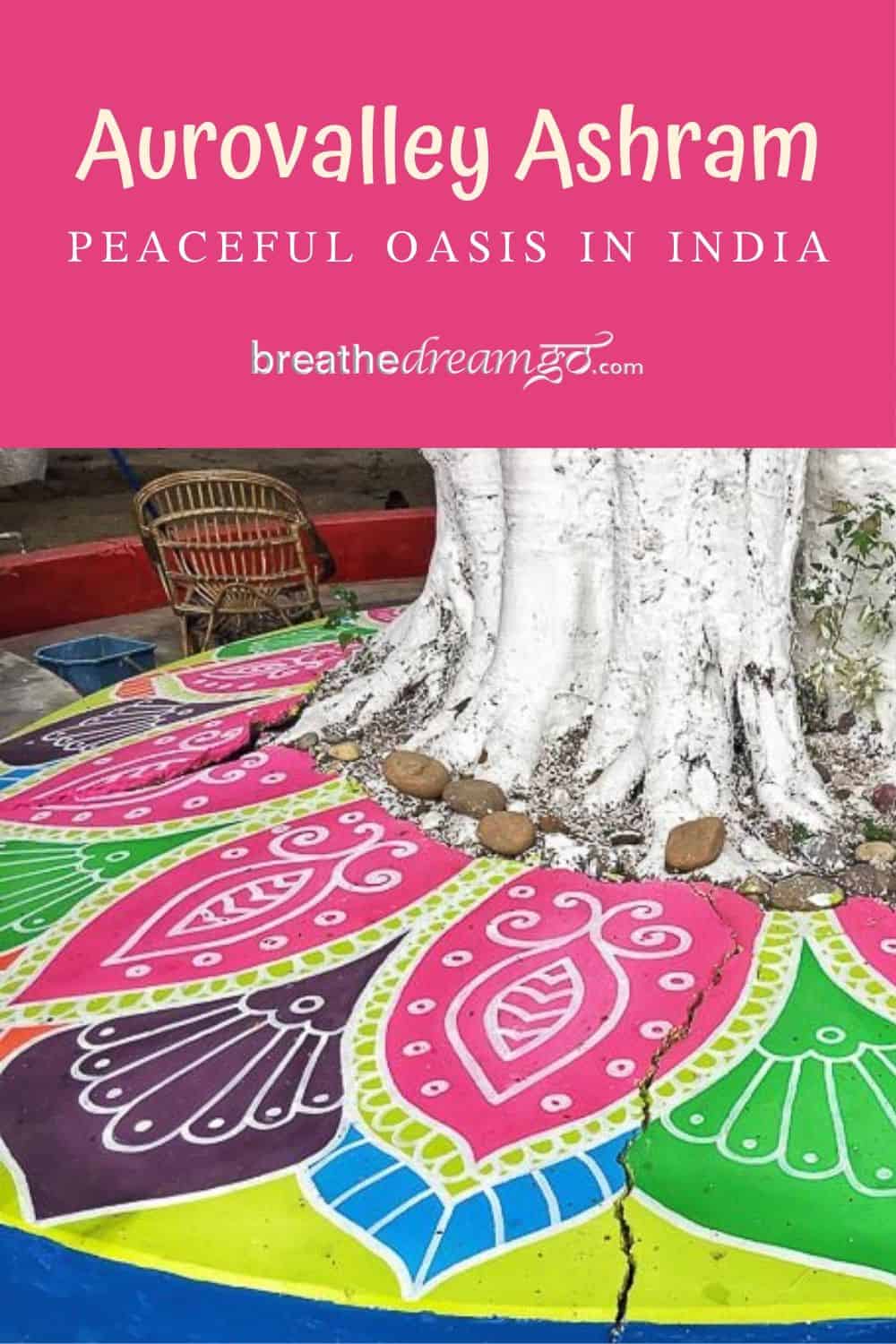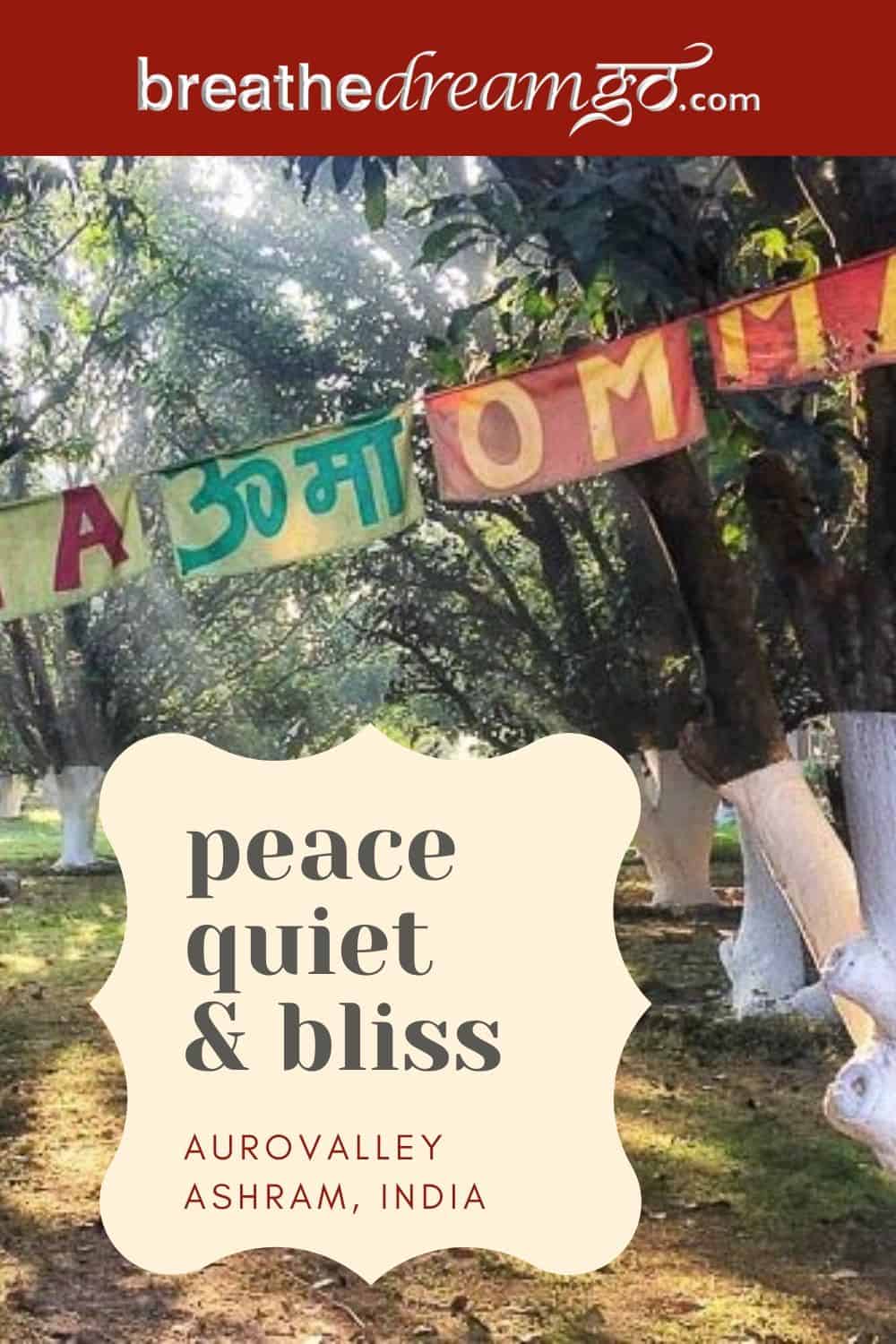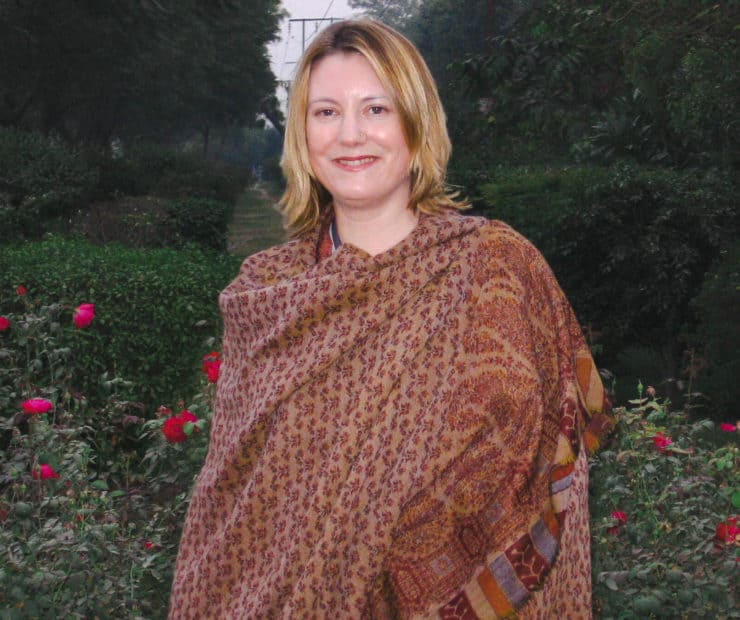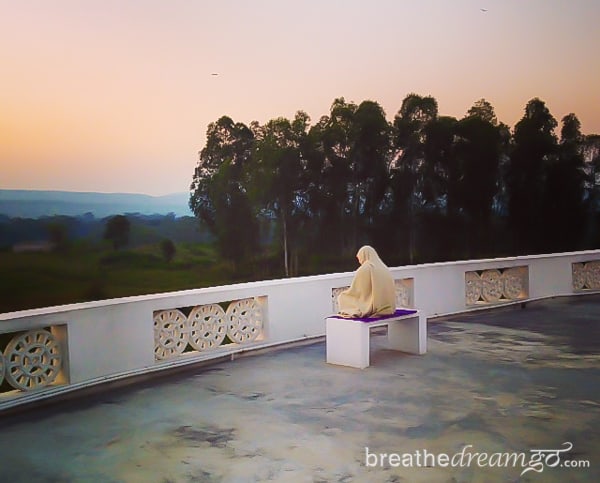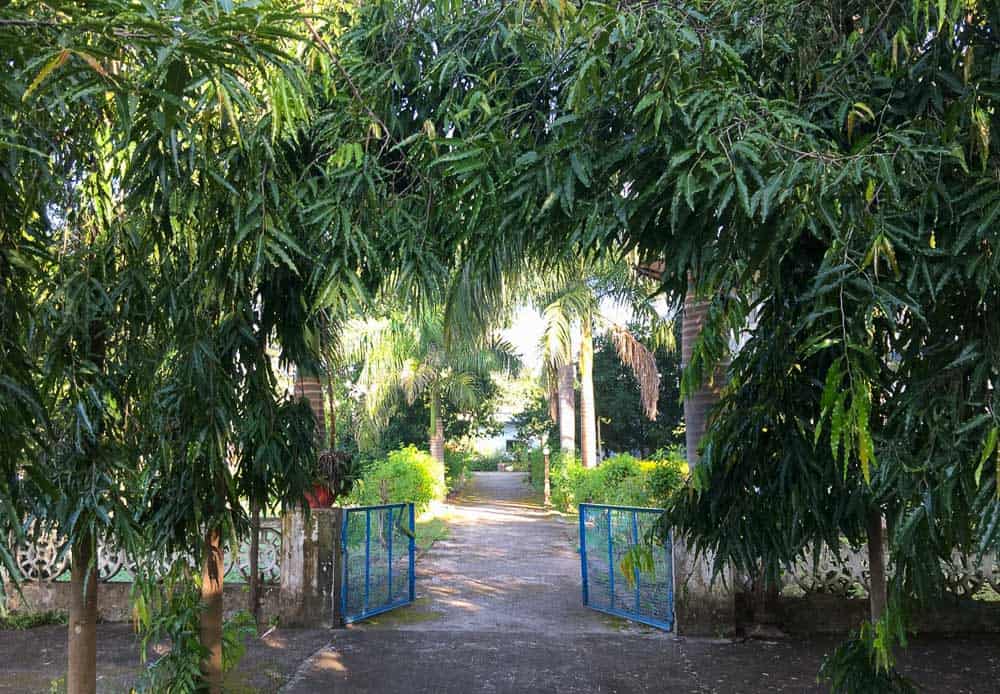
Table of Contents
Aurovalley Ashram: A peaceful, quiet, safe Yoga ashram in India
UPDATED JUNE 2020: Originally published on April 11, 2010, I am updating this post by adding new information and new photos and combining three posts into this one that were previously separate (A Day of Silence, Conscious Eating, and Shining a Light on Diwali) to give you a full picture of what life at this Yoga ashram is about. Since May 2006, I have been regularly visiting Aurovalley Ashram, and now live nearby in Rishikesh. I still consider Aurovalley Ashram to be a peaceful oasis, a quiet sanctuary, in India, and think of it often.
Aurovalley Ashram has grown and changed since I first visited in 2010, though it has continued to retain a profoundly peaceful, calm, serene environment. It is a garden ashram, full of mango trees and flowers, surrounded by meadows that attract deer (and sometimes elephants), near a tributary of the Ganga (Ganges) River, and adjacent to Rajaji National Park. This is a place for peace and quiet in India (which can seem like an oxymoron when you travel here long enough). But even though it is a deeply calm place with natural healing energy that emanates from the earth, it’s also a busy place as founder Swami Brahmdev (Swamiji) is a staunch advocate of Karma Yoga. The ashram runs a school for local children, a tailoring business for local women, a dairy, and much more to contribute positively to the local community.
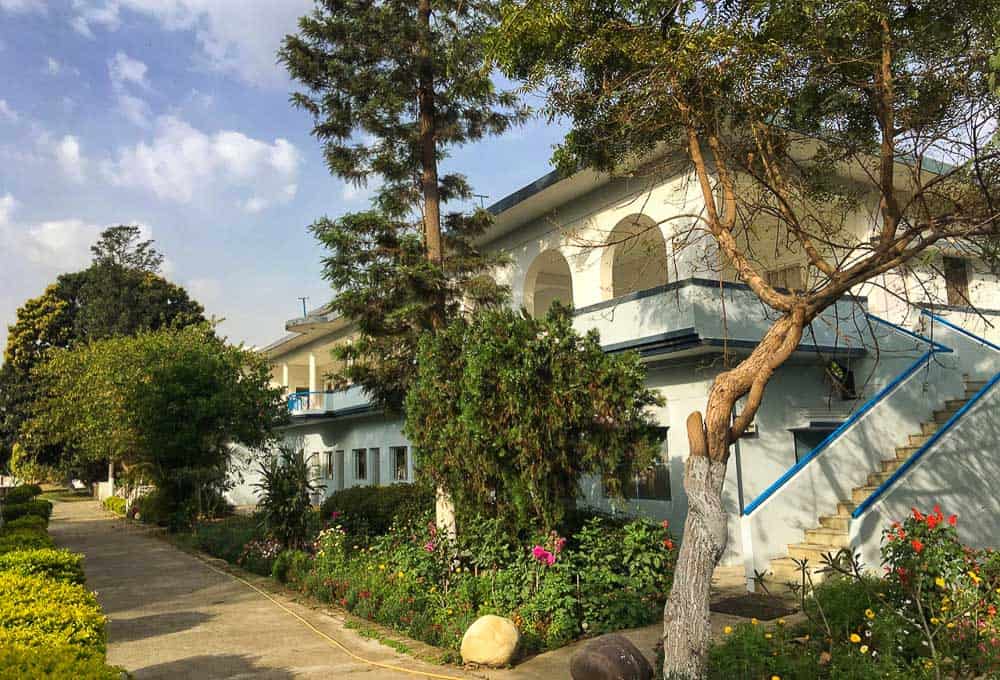
What is the daily schedule at Aurovalley Ashram?
Visitors, students, and permanent residents are welcome to join the daily routine of collective activities. These activities are meant to support your spiritual work.
| 6:00 am | Collective meditation. |
| 7:00 am | Yoga Asanas. |
| 8:00 am | Breakfast. |
| 9:00 am | Karma Yoga / Study Period. |
| 11:30 am | Satsang (questions and answers with Swami Brahmdev). |
| 1:00 pm | Lunch. |
| 3:30 pm | Tea. |
| 4:00 pm | Individual study or practice / Karma Yoga. |
| 5:00 pm | Yoga Asanas (optional). |
| 6:00 pm | Meditation / Kirtan. |
| 7:00 pm | Dinner. |
| 8:00 pm | Cultural programmes: reading, video, talks, singing, dancing. |
Where is Aurovalley Ashram located and how do you get there?
Aurovalley Ashram is located between Haridwar and Rishikesh in Uttarakhand, a state in North India.
- Address: Aurovalley Ashram Rishidwar, Raiwala, District Dehradun, Uttarakhand, India 249205
- Email address: aurovalley@hotmail.com
- Phone numbers: (91) 1352484851 or (91) 9259096978
- Location: GoogleMaps link
To get there, the three best options are:
- Drive from Delhi to Aurovalley Ashram by taxi. The drive is 5-6 hours and would cost approximately 4,000-6,500 rupees depending on the size of vehicle.
- Take the train to Haridwar and a taxi to Aurovalley Ashram. There are two Dehradun Shatabdis each day that leave from NDLS (New Delhi Railway Station).
- Fly to Jolly Grant Dehradun airport and take a taxi to Aurovalley Ashram.

My experience at peaceful Aurovalley Ashram
ORIGINALLY PUBLISHED 2010: One evening at Aurovalley Ashram, I walked out of the circular white meditation hall and into the verdant Rishidwar valley soaked in a mauve sunset. The air was filled with devotion. Devotional chants came from both the nearby sadhu’s ashram on the Ganga and from the Kumbh Mela 14 kilometres down the valley, in Haridwar. Even from the ashram grounds, I could see the lights of Kumbh Mela temples blazing on the hill tops around the sacred city. Many varieties of birds added their songs of love to the devotional mix, as did the warm breeze that blew down from the Himalayan foothills.
I was surrounded completely by nature – by the trees, flowers and birds on the ashram grounds, and the meadows and mist-covered Shivalik Hills of Rajaji National Park that surround the ashram and run alongside the Ganga, India’s most sacred river. I truly felt I was in a paradise created by, and devoted to, the love of the divine.
The next morning after breakfast, I cycled to a peaceful local Hindu temple, and from there to a spot near the ashram gate where I could walk down a rocky path to the Ganga. At the foot of the path, on the river, is a tiny temple and ghat (steps). Although it was only about 9:30 am, it was already very hot and sunny.
I sat in the cool shade of the temple watching the rolling blue-green river and listening to the water gurgle happily over a shoal. The Ganga here is luminous, it seems lit from within, and just watching it induces a refreshing feeling of peace and contentment. After some time, a sadhu (holy man) in saffron orange robes came by and dunked himself in the river. After washing himself, he proceeded to wash his orange kurtah and robes, and scrub his brass vessel with mud to clean it.
At this place, the Ganga travels through a national park and there are almost no people, no buildings here – only pristine nature. On the other side of the river are the mountains and jungles of the park – which, I am told, are home to elephants, king cobras and panthers. To see this sadhu performing his ablutions in this setting, is to see an ancient ritual that has been played out countless times by countless sadhus stretching back thousands of years: It is both commonplace and sublime.
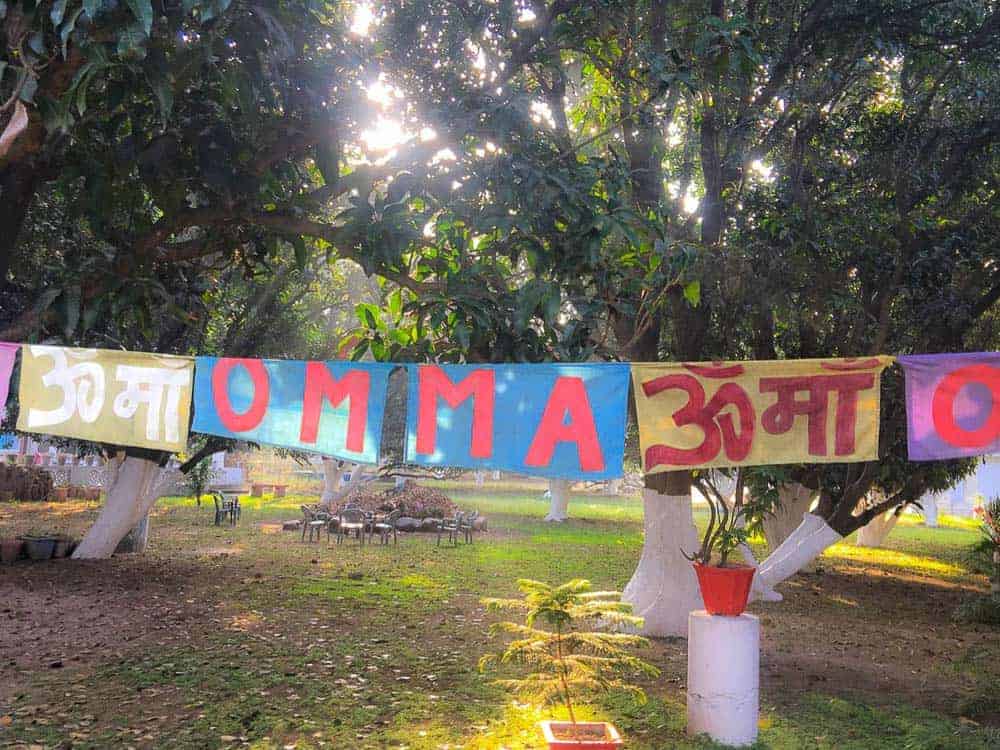
The remarkable magic of Aurovalley Ashram.
I am writing this on the white marble terrace in front of my airy room at Aurovalley Ashram. I love it here, it is probably my favourite place on earth. I have tried before to describe the peace of this place. There are some such places on earth where nature and man conspire to create havens of solitude and beauty. Aurovalley is one such place.
There is a subtle but powerful energy here that is both peaceful and healing. I have described before how I first came to this ashram on the advice of my friend Kailash, who has been coming here for many years. Soon after arriving I fell into a deep, restful, loving sleep. I slept for only about half an hour but it felt like the best sleep of my life. It was as if loving maternal arms held me as I slept. I woke and felt something I had never felt in my adult life: I felt I was at home.
Aurovalley is my spiritual home. It has everything I need to recover, heal, grow, create, do my inner work and commune with the divine. The ashram is between Rishikesh and Haridwar, but both of those sacred cities feel like three-ring circuses compared to here. It is set in the countryside, about three kilometres from the nearest village, surrounded by meadows that are ringed by Rajaji National Park. It is not only surrounded by nature, it is a celebration of nature. The ashram grounds are filled with gardens and trees, flowers and birds – it is a garden of eden, a paradise, carefully nurtured and maintained by founder Swami Brahmdev (Swamiji) and the loving people who live and work here.
I love Aurovalley for the peaceful energy and nature-oriented environment, but that’s not all. I also love the intelligently designed buildings, spaces and daily programme. My room is a simple design, all in white, and air and sunlight flow through unimpeded. It is elegant in its cleanliness and simplicity. I love meditating in the white marble circular meditation hall. Normally, I cannot achieve a deep meditation without asana practice, but in this hall there is so much help, so much deep energy that meditation is actually easy and I have had some remarkably profound insightful and healing experiences.
I love satsang (Sanskrit for “search for truth”) with Swamiji. He sits every morning from 11:30 until 1 pm, lunch time, under a grove of trees outside the library and answers questions, which is the time-honoured method of spiritual instruction in India. Swamiji teaches sadhaks (people who stay at the ashram) to increase their conscious awareness and aspire to live in full faith of the divine. He is a disciple of the teachings of Sri Aurobindo and The Mother. Sri Aurobindo’s non-fiction masterwork is The Integral Yoga — which posits that All Life is Yoga. (His fiction masterwork is the epic mystical poem Savitiri.)
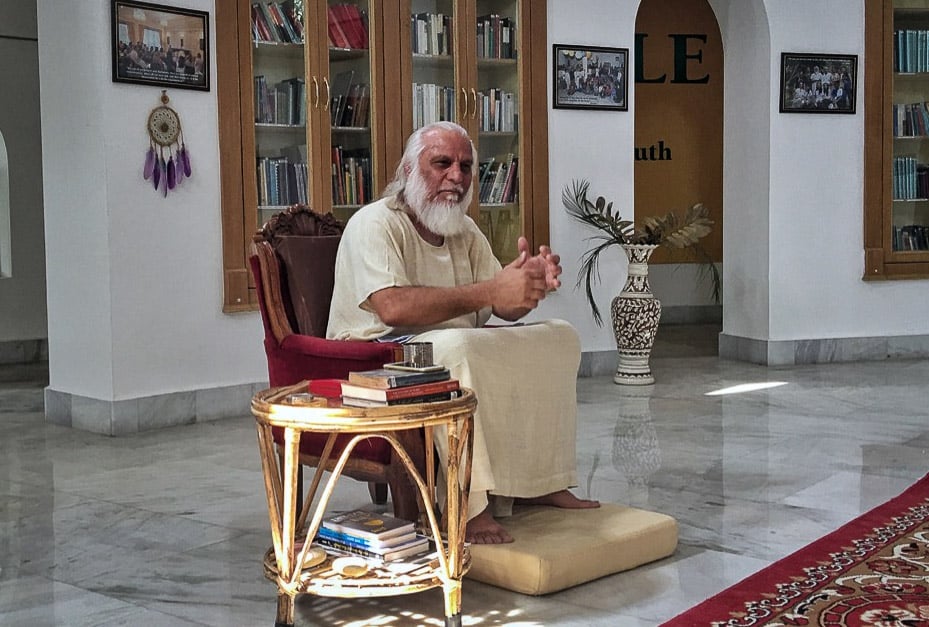
You cannot “do” yoga
But this is not the usual yoga you find at North American yoga studios. Swamiji says, “Millions of people are saying they are doing yoga, but what they are doing has nothing to do with yoga. They are doing some kind of exercises and other things. Yoga means to become One, and to become One is to be centred, to be a balanced person, a conscious person. It is not an outer thing, it is an internal thing. No one can see you are doing yoga. If anybody sees that you are doing yoga, this is not yoga. Yoga us a very secret internal process; it is a way of living with a very high understanding, with clarity. Yoga is not a subject of doing. Yoga is not to do. Yoga is an attitude. You never see a yogi doing yoga.”
The ashram takes care of all needs, including the physical: there is a daily asana class in the newly built and sun-filled yoga hall, three delicious vegetarian meals a day in the communal dining hall (some of the produce comes from the ashram’s organic garden), a library, Internet café, a store that sells books by and about Sri Aurobindo and The Mother (and lovely Auroshika products such as mala beads, oils and incense) and a new Ayurveda clinic. The clinic is staffed by a Colombian allopathic doctor who trained in Ayurveda at a university in Gujurat. She offers complete pancha karma treatment.
For me, the other main highlight of Aurovalley Ashram is its proximity to Ganga Ma, the Ganges River, mother river of India. It is only a short walk through a meadow to the river, which in this place is in a completely natural environment.
[Note: In the years since I first visited Aurovalley Ashram, the direction of the Ganga River was changed, and there is now only a small tributary flowing near the ashram.]
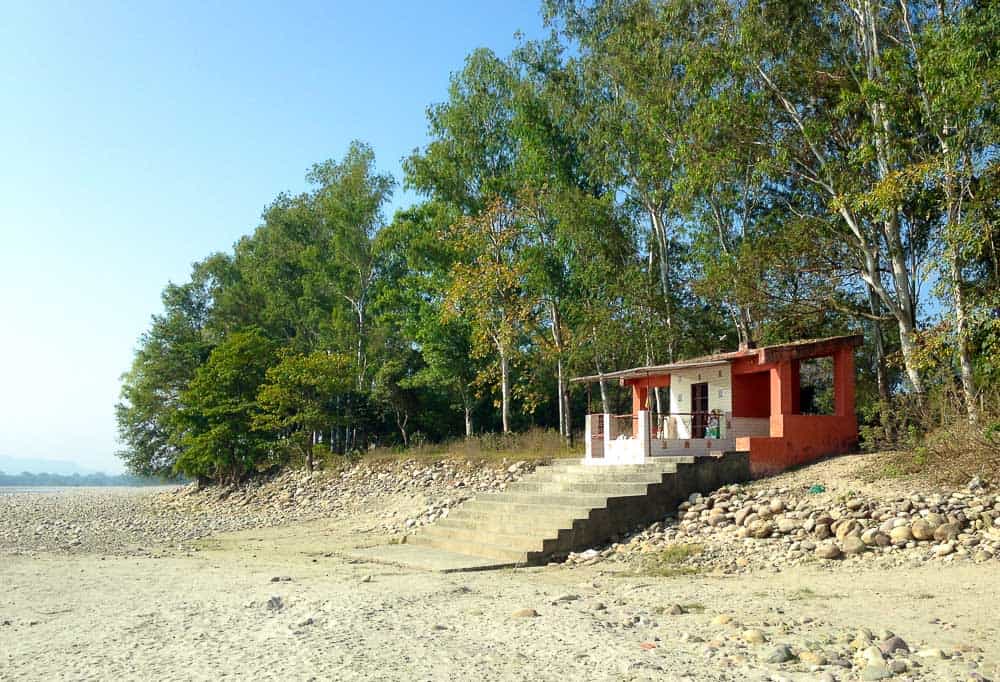
Spirituality means simplicity
Upstream from here is Rishikesh and downstream is Haridwar. This year the Maha Kumbh Mela is taking place in Haridwar and it is attracting millions of devotees. The Maha Kumbh Mela is the biggest gathering of humanity on earth. On a recent major bathing day, I went down to the Ganga at sunrise and was for some time the only person on the small ghats (steps) down to the river. It was chilly and I wasn’t sure I wanted to go in the cool water. But something bigger than me impelled me and I found myself carried by a wave of energy into the river. Coming up, I felt such exhilaration. It is very hard to explain. I was joined soon after by four Brahmin men, and we each did our puja and took our dip in silence and separateness. It was lovely, peaceful and deeply moving.
As the sun came up, it tinged the sky and glossy surface of the water an iridescent rosy pink. It was a beautiful scene, primordial in its pristine beauty, and the Hindu ritual to honour the river is ancient, too. I felt such reverence for nature; and such reverence from nature. Indeed, I feel these are the times when I feel closest to the divine
Meanwhile, downstream in Haridwar there were probably literally millions streaming into the Ganga at that same moment. I could hear the chants blaring from loudspeakers 12 kms away. I know some people love the intense energy of such a big crowd and all the attendant music, chanting, pujas, swamis, babas and the like, but I was very content with my peaceful bath.
Life at the ashram offers the rare opportunity for a very quiet, simple existence, centred around inner reflection. Lots of time for reading, writing, walking in nature, meditating. I find that I am healing on a deep level just by being here and participating in the ashram lifestyle. Every moment is an opportunity to live consciously and to grow in understanding. A carving at the entrance to the ancient oracle of Delphi said “know thyself” and that, too, could be the motto of this ashram. In this day and age it is so amazing to find a place like this that completely supports someone who wants to “know thyself” and therefore become a better person and contribute to a better world.
“Know thyself” is a way of life
But lest you think being at Aurovalley is an escape from life, or from yourself; or that it offers a naïve and unrealistic “peace and love” panacea, you have only to read some of the *inspirational* signs that are placed around the ashram grounds to discover that this ashram is quite the opposite. In fact, because Swamiji is so clear, honest and rigorous in his thinking and approach; and because the ashram provides so few distractions, there is no escape from yourself here. It is the perfect place to confront yourself and discover how you are: how you think, how you judge, how you avoid, how you evade, etc.
Swamiji is one of the most honest people I know. Some people may find his honesty bracing, but after years of Gestalt therapy I am ready for it and I find it refreshing. For example, I asked him about the concepts of samadhi, nirvana, moksha and enlightenment and he replied that they are, “varieties of ignorance.” He doesn’t agree with the idea of renouncing life or living in a cave in the Himalayas. Life is for living he says. It is to experience, to grow, to move, to change. We live in a garden and we are all gardeners. Our job is to make the garden beautiful – and we do this by living with fearless courage AND consciousness. He says, “Live in the world, but do not let the world live in you.”
Aurovalley Ashram video: Live in the present. All will be alright.
Another example: I asked Swamiji why people go to the Kumbh Mela. He said, “People have within them a need for entertainment.” Of course, he went on the explain that nature has many ways to move and change people; and people have created many ways, too, such as amusements like the Kumbh Mela, movies, etc. I exclaimed, “Is going to a movie the same as the Kumbh Mela?!” and he replied, with lightness, “Well, if it’s a very good movie,” and everyone laughed.
When asked about pain or difficulties, Swamiji says that we do not have difficulties – we have only our own rigid natures. Pain he calls a filter, and suffering a gift – they are both teachers. It seems almost everything Swamiji says has the same message: that we are here to learn, change, move and grow, and that it is nature’s, or the divine’s, way to teach us, with whatever means possible. The more positive we are in our response to life, the more conscious we become, the faster we learn.

Harmony is the hallmark of consciousness
Almost every morning satsang is eye-opening (perhaps I should say third-eye opening!). Recently, he talked at length about healing, and about how nature is filled with healing forces. He made a very persuasive argument for positive thinking and conscious healing as the best *doctor.* In fact, he said “no doctor, no illness.” He teaches that we become what we think. If we think we are healthy, we will be. If we think we are sick, we will be.
There are many wonderful people who work hard and contribute to making this such a clean, well-maintained and conscious place, but it is primarily the vision of Swamiji, who came here more than 20 years ago when it was just a jungle, and who slowly built it into what it is today – a sanctuary of conscious living. If harmony is the hallmark of consciousness, as Swamiji remarked during satsang, then Aurovalley must be a highly conscious place indeed.
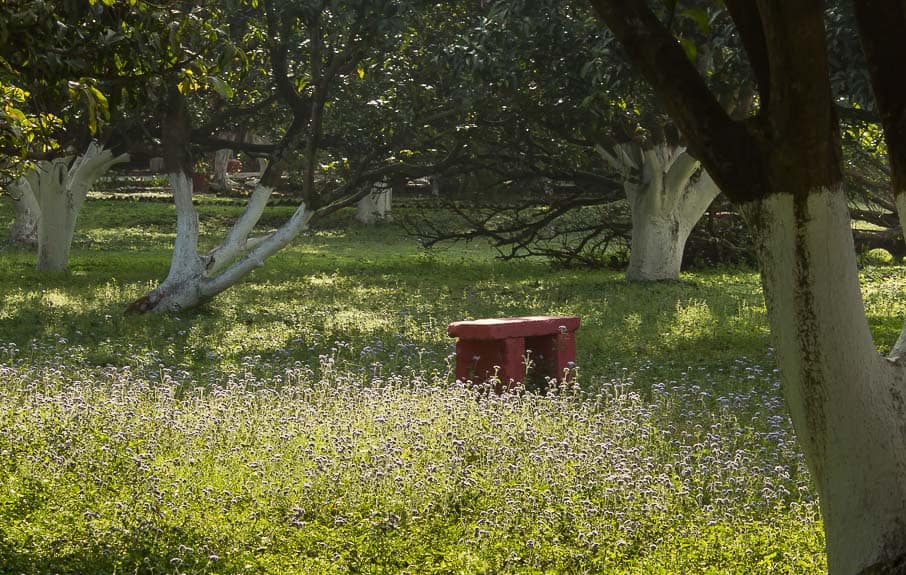
An experiment with silence at Aurovalley Ashram
ORIGINALLY PUBLISHED APRIL 2015: It’s a rare rainy day in March at Aurovalley Ashram and I’m listening for the sound of silence. I can hear silence in the sound of tiny drops of water landing on the earth. I can hear silence in the bright flowers that sway with happiness in the light breeze. I can hear silence in the moving joy of the butterflies, unheeding the gentle rain. I can hear silence in the chirps of the sparrows, the songs of the parakeets, the shrieks of the peacocks. I can hear silence in the mighty thick pastiches of clouds.
In nature, silence is the manifest of the divine. There is never a sound out of place. Even with the roar of a waterfall or the rumble of thunder, you can be alone with yourself. The silence and the sound are as one. They envelope you with their inner stillness, their spontaneous expression.
Silence is a necessity for discovering yourself. But in today’s world, silence is becoming a rare and treasured luxury. Silence is one of the characteristics of nature and of profoundly peaceful spiritual centres, like Aurovalley Ashram — and the reason people are drawn to these sacred places.
Here at Aurovalley Ashram in the Garwhal region of Uttarakhand, India, the silence is profoundly peaceful. Surrounded by the Shivaliks, the foothills of the Himalayas, Rajaji National Park, meadows of wild basil and grazing cows, rich farmland and a gentle tributary of the Ganga (Ganges) River, there is little to break the spell.
Since childhood at our family cottage on a lake in central Ontario, Canada, I have loved to be alone in a summery, natural environment. I have distinct memories of paddling the big, wood canoe to the shallow edges of the bay, and dreamily watching the undulating seaweed, darting crayfish and flashing minnows. I lost myself, my sense of time and space, as I immersed in the natural world, becoming one with it if only for a moment.
Those moments were laced with eternity, and very similar to what I find at Aurovalley Ashram. Spiritual peace is akin to the carefree innocence of childhood, in many ways, and the sunny flower-filled meadows of this valley, through which the Ganga runs, remind me of those cottage meadows of my youth.
Then, as now, I have loved to soak up the silence of nature. Today, it is probably the most luxurious “commodity” as our world becomes increasingly crowded, industrialized and noisy. Silence is one of the reasons Aurovalley Ashram founder Swami Brahmdev (Swamiji) created this heaven-on-earth.
“Silence is the nature of the divine, it is the expression of your soul,” Swamiji says. “Wherever there is silence, there is soul, there is divine, there is presence. Life expresses itself in silence.”
Silence is a fragrance of soul.
Swamiji recommends that people who come to Aurovalley Ashram experiment with silence. He says, “Watch nature, see how nature expresses herself in silence. Make an effort to be silent and see what happens. Something will awaken in you. Life will become clear, simple. Only in silence can you discover yourself.”
At Aurovalley Ashram, and many other ashrams and spiritual centres, you can actively pursue a silent retreat. You can wear a badge indicating that you are in silence for a day, a week or even longer.
Swamiji explains that most of the time, we are reacting. Reactions are mostly negative, and a waste of energy. If you look at nature, it does not react. Nature expresses her divinity. If we, too, are silent, we can learn to spontaneously express ourselves. “Silence is your true nature.”
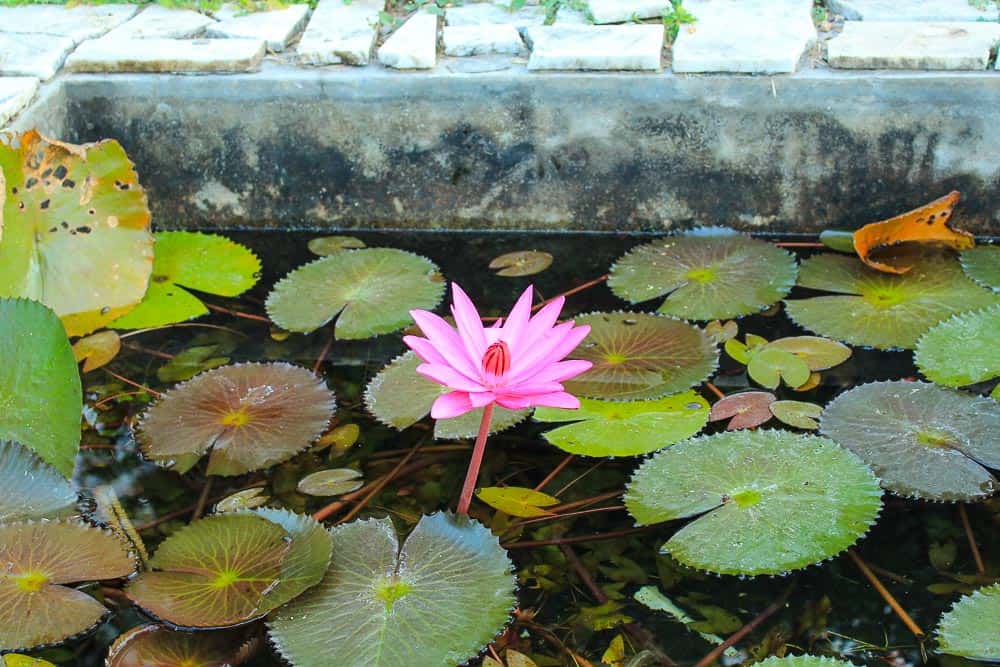
My experiments with silence
I tried the silent experiment for a day at the ashram. I actually found it a relief. I was given permission to be in my own little world — an introvert’s idea of bliss.
Slowly, over the course of the day, I began to see the world differently. Human noises became almost unbearable, while the sounds of nature became much more joyful.
By late afternoon, everything began to take on a different dimension, as if I was entering an altered state — or a truer way of seeing. I noticed things I had never noticed before.
Silence is the birthplace of your soul.
I walked around the grounds of the ashram to try and take “photos of silence” and saw flowers in a new way, as more detailed and individualistic. I also used my telephoto lens to shoot them, and came up with a new (for me) photography style.
During evening meditation, I felt myself sinking down into the depths, as if diving in the ocean. I thought of the Marabar Caves and the timeless echo from the book A Passage to India.
After dark, I walked on the roof of the World Temple, and saw lights on the distant hill tops that I had never seen before.
Speech is silver, silence is golden.
I saw an illumination, an undulating sense of the world as a living organism. I fell in love with creation. I was punch drunk with love as I danced on the roof, the stars twinkling above, devotional music from a nearby temple wafting on the breeze and the warm spring evening enveloping me with tenderness.
In the silent chamber of my inner being I sensed a spiritual truth often lost in the rush and din of everyday life. I sensed the pulsing oneness of creation, and myself as part of it, alive and flowing, moving, breathing together … on a silent rooftop in north India.
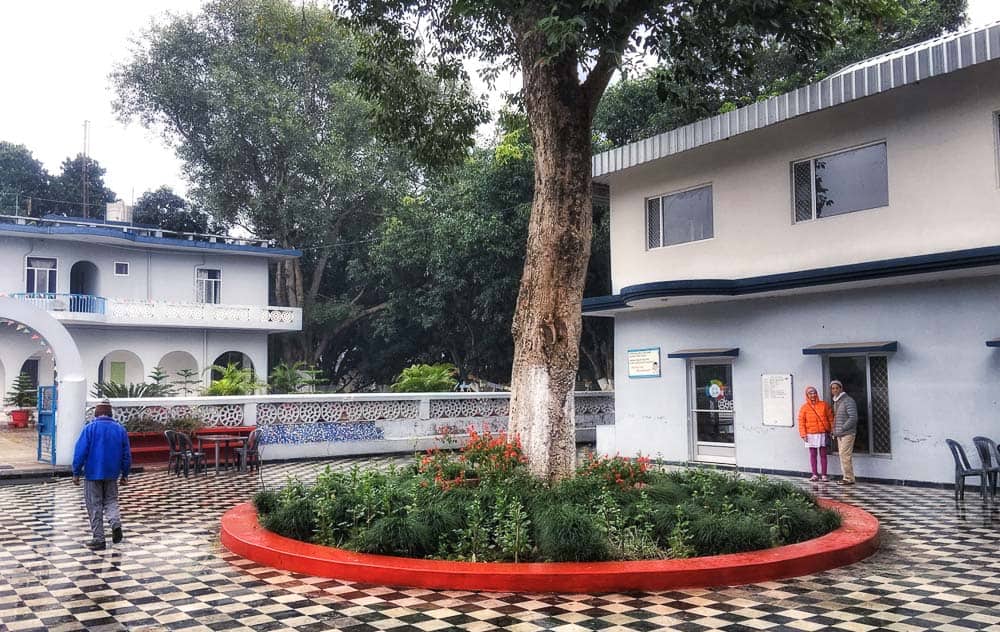
Conscious eating at Aurovalley Ashram
ORIGINALLY PUBLISHED FEBRUARY 2015: Aurovalley Ashram in north India is a place for seekers to find peace. Aurovalley Ashram founder Swami Brahmdev describes the ashram as an experiment in consciousness living. It’s also an experiment in conscious eating and sustainable food production.
Three times every day, several of the women who live and work at Aurovalley Ashram line up behind the counter and ladle mild, vegetarian food, like rice, dal, and sabzi (vegetable) onto the stainless steel thali (plates) each person carries. The basic fare is usually enlivened by the addition of things like fresh salad, fruit, home made curd (yoghurt), hot ginger tea, buttermilk or home made pickles.
It’s not food that’s going to win any awards, and it’s not what foodies dream about, but it is simple, healthy, nutritious and vital. At Aurovalley Ashram, food is part of the spiritual life. People are expected to eat in silence, and clean their own plates afterwards.
Aurovalley Ashram founder Swami Brahmdev explains that eating in silence gives ashramites the opportunity to experience food as a divine gift. “When you’re eating, you are in direct contact with the divine. By eating in silence, you show gratitude for life-giving food.”
I have found eating in silence to be more difficult than it sounds. In fact, it can be a life-changing experience to eat in awareness. I remember the first time I did it, at the ashram several years ago, and I actually started crying. I discovered that I was eating in a state of anxiety, and this “experiment” released a lot of pent-up emotion.
Since then, I have learned to love peaceful mealtimes. When the weather permits, which is most of the time, I sit outside at the base of a large tree, or on the tiled roof, among the palm tree branches.
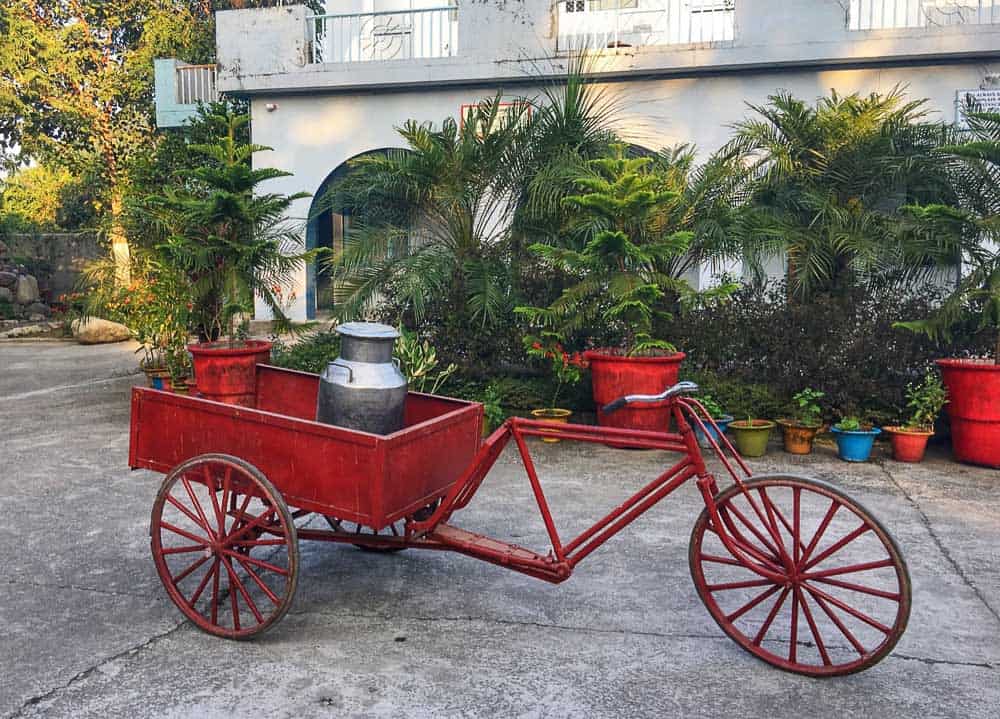
A conscious approach to food
Food is also part of the spiritual life in the sense that it is collected and disposed of in a responsible manner. Swami Brahmdev and Dhyana — a woman from Colombia who has been helping run and manage Aurovalley Ashram for about 12 years — and the others who are involved in buying and cooking the food are all keenly aware of making sustainable choices. The fruit and vegetables grown on the ashram grounds, and the dairy goods produced, are all organic.
A large kitchen garden is planted throughout the year with fruits and vegetables in season. Carrots and potato in winter; lettuce in spring; bindi (lady fingers) and jack fruit in monsoon; pumpkin in the fall — as well as cabbage, bengan (eggplant), tomatoes, strawberries.
When the buttery soft lettuce is growing, green salads are common and very welcome. In India, salad is often a risky thing to eat due to hygienic concerns. But at Aurovalley, the food is absolutely clean, safe and organic.
Just on the periphery of the ashram grounds, a goshala (cow shed) is home to half-a-dozen cows. When I was there recently, one of the cows had given birth, which meant milk was readily available. Every day, we were treated to completely fresh milk products, like curd, buttermilk, ghee and lassis. I watched one of the local men milk the cow, using simply his bare hands and a clean bucket.
Kitchen staff, including long-time cook Mohan, make pickles from the fruit of the ashram trees. When I was there in February, the amla trees had borne fruit, and I ate amla pickles almost every day. During summer, the dozens of mango trees on the ashram property come into season, and mangoes are picked and eaten right from the trees, and also made into chutney, pickles and juice, and added to lassis and salads.
If they have to buy foods to supplement what they produce — things like rice, beans and bananas — they choose organic foods when possible, and either avoid or reuse plastic containers. Periodically, a vegetable walla shows up, with things like big heads of cauliflower and small sweet apples piled up on a wooden cart.
Water is of course a big concern to Indians and travellers alike. Tap water is deemed to be unsafe and plastic bottles litter the landscape. At Aurovalley, a large reverse osmosis filter provides clean water. Residents simply fill up their reusable bottles.
Responsible and sustainable food production includes garbage disposal. At Aurovalley, all the organic waste is fed to the cows and dogs, paper is burned and gardening waste is composted. There is almost nothing left, except for plastic and glass, which is reused.
Back to the earth
It’s very satisfying for a city girl like me to be so close to the food I am eating, and to eat such astonishingly fresh food. One morning, I saw one of the girls who lives on the ashram grounds with her mother pick lettuce that we ate shortly afterwards at lunch. It wasn’t cut, but served as full leaves, which I ate with my hands. It seemed to be filled with sunlight and goodness, happy food from a peaceful garden.
At lunch, sitting on the roof eating the lettuce salad, I noticed a drop of water hanging at the end of a palm tree leaf, and reflecting eternity from its tiny mass. A glossy green parakeet landed on a nearby branch. Looking further, I saw mist floating on the ruddy, golden field and turning the distance forest into cloud. All I could hear were the sounds of birds singing and palm leaves rustling in the warm breeze.
This is harmony, I thought as my heart expanded with love for the perfection of nature all around me — the palm trees, the parakeets, the mist-covered forest and the golden lettuce.
Learning to live with more consciousness is the goal of Aurovalley Ashram, and that includes raising awareness around food choices.
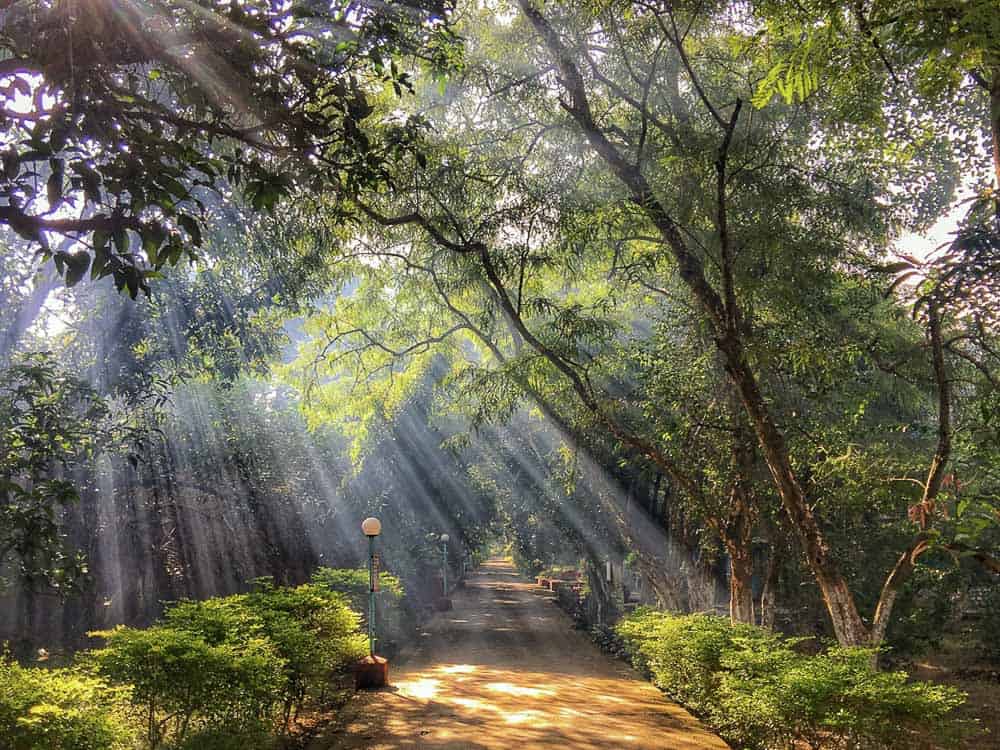
Shining a light on Diwali at Aurovalley Ashram
ORIGINALLY PUBLISHED NOVEMBER 2015: Diwali is India’s Christmas, a festival that’s celebrated in spectacular fashion all across the country by people of all religions, though it’s actually Hindu. Families gather to enjoy time together, to perform Lakshmi Puja, to create rangolis, eat sweets and light candles and fireworks. The origin of Diwali is the epic Ramayana, the tale of Lord Rama, and the lights are meant to help guide him back from exile.
There are five days of Diwali, each with a different significance, and the festival culminates on the night of the new moon, the darkest night of the year. Diwali is also known as the Festival of Light because on this night, diyas (small clay lamps) are placed in rows all along balconies, stairs, rooftops, walls and other places outdoors. After dark, the diyas are lit and people shoot fireworks into the night sky. The entire country lights up in a spectacular display that signifies the triumph of light over dark, and the victory of good over evil. Read more here about How to celebrate Diwali in India.
One year, I spent Diwali at Aurovalley Ashram. On the day of Diwali, everyone staying at the ashram (about 20 people, from Canada, England, Colombia, Russia and of course India) spent the day cleaning, decorating and affixing small candles along pathways, stairs, balconies and walls.
As always, we spent one hour in collective meditation before dinner. The Meditation Temple was elaborately decorated with flowers and candles, and shone with incredible brightness that seemed to penetrate my consciousness.
Just before dinner, we lit the outdoor candles and watched the ashram glow, while the sounds of firecrackers from the nearby village broke the usual stillness. After dinner, we all went into the World Temple where we watched a music and dance performance. Then we went up to the roof and danced with sparklers and lit fireworks, everyone including Swami Brahmdev beaming with joy and happiness, like children. Finally, someone started playing Bollywood dance tunes and Bhangra, and all the women ran downstairs, onto the World Temple lawn, to dance into the night.
Spiritual significance of Diwali
It was a fun night, and also a significant one. During Satsang, the daily question-and-answer period, I asked Swami Brahmdev (Swamiji) for the spiritual significance of Diwali, and he said: “You are made of light. But you forget. Diwali helps you discover that you are light. The ritual helps to awaken the light within. It helps you journey from darkness to light.
Diwali should be each moment of life.
“Light means consciousness, wisdom. It refers to your higher self, your best self, your true nature. The whole year, you should be remembering your light, not just one day.
“This is the darkest night of the year, and the festival reminds us to light a candle within. Burn your candle on the inside. We are habituated to look outside, but the real work is to burn the inner light. Diwali should be each moment of life.”
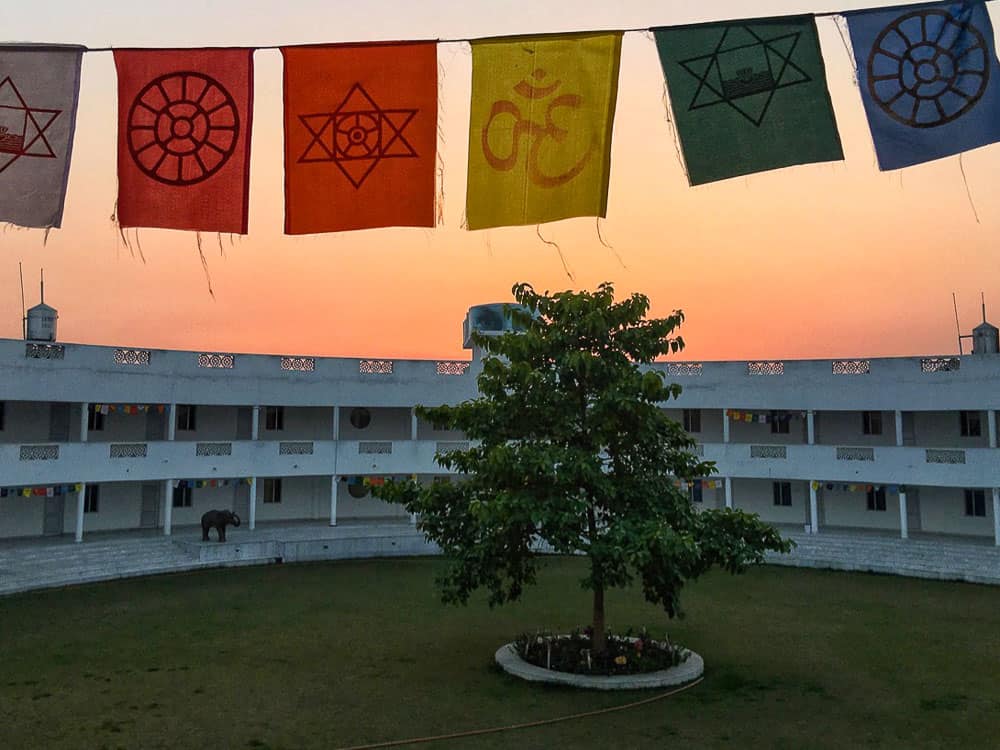
The purpose of ashram life
I have written often about Aurovalley Ashram, as I have been visiting this lovely, peaceful spot for almost 10 years, and you can read some of my previous blogs below. A significant number of people who show up at Aurovalley find their way there after reading one or more of my blog posts. In many cases, staying at the ashram changes their life in some profound way — and this makes me feel as if I have done something valuable and positive with my writing.
For those who are cynical about spiritual centres, like ashrams, and “godmen” as they are called in India, I can certainly empathize. There are so many frauds, and so many superficial retreats. In India, there are people who dress up like swamis to cheat the innocent and vulnerable. Among westerners, there are those who take one-month yoga teacher training courses, set themselves up as gurus and open yoga studios and retreats.
Others may not be as cynical, but just may wonder about the purpose of time spent at an ashram. They may think they don’t need it, or that it’s unnecessary, and they don’t see the point.
Well, of course, if you’re not drawn to visit an ashram, there’s probably no point in going. But if you are curious, you may find, like me, there is a kind of luxury at an ashram you won’t find anywhere else, not even at a seven-star tropical resort.
At a place like Aurovalley, there is the luxury of time to be with yourself. By yourself, I mean your inner self, your higher self. An ashram is the one place where you are encouraged to sit quietly and ponder questions such as:
- How should I live my life?
- What is the purpose of life?
- Who am I?
- How can I bring more consciousness to my life and my work?
- What is my gift, what am I supposed to manifest in my life?
Aurovalley is a particularly special place because it offers two things in ample amounts: peace and freedom. I would not be surprised to learn there is no other ashram like it in India. It is physically and materially very well made and comfortable, with spacious clean rooms and hot showers, two asana classes per day in a beautiful yoga hall and a stunning library, among other amenities. It’s also well-located halfway between Rishikesh and Haridwar, surrounded by fields, close to the Ganga River and ringed with the mist-covered hills of Rajaji National Park.
But much more importantly, it is a deeply peaceful place, where your entire being can unwind. There is a daily routine, which you are expected to take part in, and you are given the freedom to discover your own unique spiritual path.
As far as we can discern, the sole purpose of human existence is to kindle a light in the darkness of mere being. – Carl Jung
Ashrams give you a break from the daily grind of life — but much more so than any vacation can offer. This is hard to explain if you haven’t experienced it. At Aurovalley, the silence and peace allow you to hear your innermost thoughts, to feel your deepest emotions, to sense the movements of your soul … and “to kindle a light in the darkness of mere being.”
Your cares are lifted for a time and you have the opportunity to reflect and meditate, and gain increased awareness about your life. Every time I come to Aurovalley, I undergo an important paradigm shift in awareness, and I feel my consciousness expand a little. Cares seem to grow smaller and become more manageable, and I leave with a spring in my step.
Relevance in times of tragedy
You may also wonder: What’s the use of sitting around meditating when there is war, poverty, terrorism and other horrors in the world. Are ashrams and places like them an anachronism is today’s modern world?
The day after the Friday the 13th attacks on Paris, I asked Swami Brahmdev about how we should respond. He said:
“Any kind of catastrophe, horror, attack, tragedy shakes us up. They make us ask ourselves about finding sense and purpose in life. These attacks are a clear sign that we need to grow our consciousness. Sometimes people learn from these incidents.
“We are social animals, and social animals fight. But we have the chance to be more. Every day we have the chance to make changes, to progress, to learn. Change is the most beautiful secret to life. Consciously participate in positive change.”
Then Swamiji recited a short Hindi poem, and translated it. He said, about life, “You’ve given me many ups and downs. But now I’m in charge, I’m calling the tune!”
This powerful and radical message lit a spark in me and has helped move me forward more positively and confidently. I now feel better able to deal with some major challenges in my life. Personally, I think most of us could benefit from a better understanding of how truly powerful we are. And how capable of igniting change.
Note: I would like to recognize the origins of Yoga as a school of Hinduism, an art and science that has been fostered from time immemorial in India. As someone who is not from this culture, I owe respect and gratitude to the Yoga teachers and traditions that I have learned and benefitted from. Pranam to all.
Pin it on Pinterest
If you enjoyed this post, you can….
ign up to The Travel Newsletter in the sidebar and follow Breathedreamgo on all social media platforms including Instagram, TripAdvisor, Facebook, Pinterest, and Twitter. Thank you!


